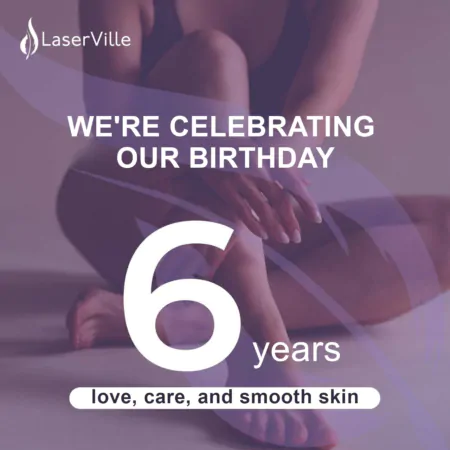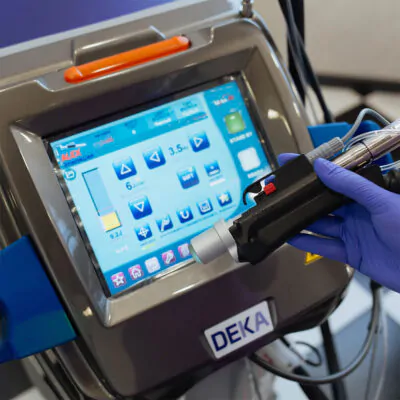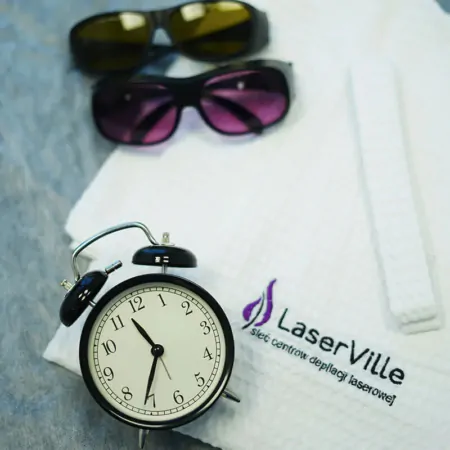Hair removal methods: which epilation method is right for you?
Contents
- ❓ Depilation or epilation: what is the difference?
- ❓ Depilation methods: pros and cons of hair removal techniques
- ❓ Depilation methods: contraindications
- ❓ Epilation methods: pros and cons, differences, and contraindications for each method
- ❓ Laser hair removal – the best method
- ❓ Ultrasound epilation
- ❓ Principle of the alexandrite dynamic laser Motus AX
- ❓ Hair removal methods: summary
Hair removal is one of the most popular and in-demand cosmetic procedures in the modern world. However, not all hair removal methods are equally effective, safe, or accessible. This raises a logical question: what hair removal and depilation options are available, and how do you choose the most suitable method to get rid of unwanted body and facial hair?
In this article, we will discuss various hair removal techniques such as shaving, waxing, sugaring, epilators, laser hair removal, photoepilation, and more. We will review their advantages and disadvantages and help you choose the best hair removal method to suit your needs and preferences.
Depilation or epilation: what is the difference?
In everyday language, these types of hair removal are often confused and used interchangeably. While this mistake is not critical, if you want to understand the difference, here it is.
Depilation is the removal of part of the hair above the skin’s surface or along with the root, but without damaging the hair follicle.
Epilation is the effective removal of hair by destroying the hair bulb (follicle).
Depilation methods: pros and cons of hair removal techniques
The most well-known depilation methods are shaving, dissolving hair with chemical agents, mechanical hair removal (waxing, sugaring, using epilators, tweezers, erasers, and threads). Let’s take a closer look at the different types of depilation methods.
Shaving
The most popular and simple method of hair removal.
Pros:
- cheap in the short term;
- no need to book appointments or go to a salon, control procedure dates;
- can remove even very short hairs.
Cons:
- irritation;
- dryness and peeling of the skin;
- cuts;
- ingrown hairs;
- hairs grow back quickly;
- new hairs are coarse and stiff.
Chemical depilation
Cream, lotion, gel, or spray contains substances that dissolve the protein structure of the hair. The hair follicle remains unchanged, and the hair grows back as before.
Pros:
- new hairs grow back soft;
- easy;
- painless;
- convenient at home.
Cons:
- requires frequent application – every 1-7 days (though ingredients are added to slow hair growth);
- redness;
- inflammation;
- allergic reactions and mucous membrane burns from chemical agents;
- products are effective at specific temperatures;
- cannot be used on sensitive areas of the skin.
Mechanical hair removal
Sometimes this method is mistakenly called “mechanical epilation”, but it is actually depilation. Mechanical hair removal is the process of pulling hairs from the skin using various tools or methods. There are different types of mechanical hair removal, which vary in effectiveness, cost, and convenience. Let’s look at some of them in detail.
Waxing
Waxing is a method of hair removal that extracts hair from the root using wax, which is applied to the skin and then removed with the help of paper or fabric strips.
There are 2 types of wax for this procedure: cold and hot.
Pros:
- can be done at home;
- effect lasts about 2-3 weeks;
- reduces hair growth activity.
Cons:
- the procedure is painful;
- hot wax procedures are best done in a salon to control heating temperature and avoid skin burns;
- ingrown hairs;
- hairs need to grow out a few millimeters for the procedure.
Sugaring
This type of depilation is quite similar to the previous one. The difference is that sugar paste is applied only to the hairs, unlike wax. After the paste hardens, it is removed along with the adhered hairs.
Pros:
- less damage to the skin compared to waxing;
- result lasts several weeks;
- can be done at home;
- relatively simple procedure;
- hairs will be thin after regrowth.
Cons:
- painful;
- possible allergic reactions;
- ingrown hairs;
- procedure is only possible with hairs a few millimeters long.
Thread depilation (threading)
An ancient method of hair removal that is still used today. It involves physically plucking hair using a thread, a technique known as threading. Several hairs are captured and removed at once.
Pros:
- low risk of skin damage;
- result lasts several weeks;
- effective for fine and light hairs.
Cons:
- ingrown hairs;
- painful;
- time-consuming procedure, not suitable for large skin areas.
Epilator
An epilator is an electric device for mechanical hair removal with multiple “tweezers” that grab and pull several hairs at once.
Pros:
- relatively fast;
- hygienic (due to individual devices);
- effect lasts 1-3 weeks;
- convenient for home use.
Cons:
- painfulness;
- irritations;
- some hairs are broken off without the root at the high speed of the epilator and start to grow back quickly;
- many hairs can ingrow into the skin.
Tweezers
A simple and indispensable tool found in every home, tweezers can be useful for removing hair.
Pros:
- can be used anytime, in any conditions;
- suitable for fine and vellus hairs;
- a useful tool that complements other hair removal methods.
Cons:
- painful;
- very time-consuming as each hair must be plucked individually;
- risk of ingrown hairs.
Crystal hair remover for hair removal
The abrasive crystal hair remover, also known as Nano Crystal Hair Removal, is a method that removes hair through friction. As the tool is rubbed against the skin, the hair twists and breaks off at the base. At first glance, this device doesn’t look like a typical hair removal tool — it resembles a handleless comb, but instead of teeth, it has a rough glass surface.
Like all other body hair removal methods, the crystal epilator has its pros and cons. However, it’s worth noting that most online users who have tried this method tend to agree that its disadvantages significantly outweigh the benefits.
Pros:
- convenience for home use;
- exfoliates dead skin cells;
- relatively inexpensive and durable tool.
Cons:
- time-consuming procedure;
- does not guarantee complete hair removal;
- may cause irritation, inflammation, infection, or scarring;
- not suitable for sensitive skin and contraindicated in some conditions;
- not recommended for underarms, bikini area, and face.
Depilation methods: contraindications
Many are interested in the limitations of different depilation methods. There are practically no contraindications for shaving, except for papillomas and a large number of moles.
Chemical depilation: individual intolerance, allergies, predisposition to keloid scarring, and other conditions that may worsen with painful irritation.
Mechanical hair removal methods are not suitable for people with a low pain threshold and in some cases for those with diabetes, as it can reduce skin healing and increase the risk of septic complications.
Epilation methods: pros and cons, differences, and contraindications for each method
What is epilation? It refers to various methods of destroying the hair follicle with the goal of stopping hair growth. Below, we’ll explore the most popular types of epilation — their pros and cons, key features, and contraindications. This will help you decide which hair removal method is best suited for you.
Electroepilation
Electroepilation is a general term encompassing various methods of hair removal using an electrical charge directed at the hair follicle. Electroepilation can remove hair of any color, thickness, and location, including gray, coarse, and light hair. However, electroepilation has its pros and cons that should be considered before the procedure. Below, we will discuss the most popular methods of this type of hair removal.
Thermolysis
Uses high-frequency alternating current. A needle must be inserted into each follicle through which an electrical impulse is delivered. The hair follicle is instantly destroyed due to rapid heating.
Advanced thermolysis is the flash method. The principle is the same as the galvanic effect. The difference from thermolysis is that a high-frequency direct current is used, and the exposure to the hair is only 0.01-0.09 seconds. The needles are insulated, making the procedure less painful. There is the option to choose modes on the control unit.
Sequential flash. This is an advanced flash method. High-frequency alternating current and pulses of varying durations are used. This allows the practitioner to adjust the pulse duration based on hair thickness. For coarse hair, the pulse is shorter, and the current strength is higher.
Pros:
- long-lasting effect – up to several years;
- suitable for all hair types, colors, lengths, and thicknesses.
Cons:
- skin inflammation;
- painful;
- irritation;
- swelling;
- infection;
- scarring;
- pigmentation;
- requires multiple sessions;
- prolonged healing of wounds after the procedure.
Electrolysis
This hair removal method involves destroying the hair follicle using electric current delivered through a thin electrode needle inserted into the hair follicle. The pros mostly overlap with the previous method.
The cons are also largely similar to thermolysis, but this method:
- is even more painful than thermolysis;
- requires more time;
- requires greater precision and skill from the practitioner.
Blend
A device that combines electrolysis and thermolysis methods.
Pros:
Sequential blend. This is an advanced blend method: to enhance the follicle destruction effect, the amplitude of the direct current is reduced at the moment of impulse introduction. Thus, the impact on the follicle is more intense, and painful sensations are reduced.
Cons:
- frequent inflammatory processes;
- painful;
- irritation;
- swelling;
- infection;
- scarring;
- requires multiple sessions;
- skin pigmentation.
Electric epilation methods: contraindications
Contraindications for electroepilation include skin diseases, wounds, pregnancy and lactation, and neuropsychiatric disorders.
Light-based epilation – effective hair removal
Light-based epilation methods use light radiation of different wavelengths, which is absorbed by the melanin pigment and converted into heat that destroys the hair follicle. Let’s look in detail at a few of these methods.
Photoepilation
Type of light epilation using intense pulsed light. The effect of halting hair growth is explained by the photo-thermal destruction of follicles.
Pros:
- contactless method of impact;
- minimal skin damage;
- long-term effect – several months or even over a year;
- high speed of the procedure;
- stimulates collagen production, which rejuvenates the skin.
Cons:
- only effective on dark hair;
- the procedure is accompanied by painful sensations;
- ineffective on light and fine hair;
- not recommended for sensitive skin areas, e.g., for bikini epilation;
- possible burns and skin pigmentation.
Laser hair removal – the best method
This method involves radical hair removal using laser radiation. The hair follicle absorbs the light wave, melanin heats up, destroying the cells involved in hair growth and the blood vessels that nourish the root.
Main Types of Lasers:
- ruby;
- alexandrite;
- neodymium;
- diode.
Pros:
- the laser impacts the hair in such a way that the follicle does not regenerate;
- effectiveness – results last for several years or even a decade (with occasional maintenance procedures);
- less pain or even complete painlessness;
- absence of allergic reactions;
- no ingrown hairs;
- suitable for all body areas.
Note: Depending on the type of laser and additional features such as advanced technologies, the level of discomfort, speed, and effectiveness of the procedure can vary significantly. For example, the Alexandrite laser Motus AX with MOVEO technology not only outperforms other hair removal and depilation methods in terms of effectiveness but also ensures a completely painless experience.
Cons:
- ineffective on light, gray, and fine hair;
- sometimes not applicable on tanned skin (depends on the type of laser).
Ultrasound epilation
This hair removal method, although not a light-based method, is conceptually similar. Enzymes in the form of gel are introduced into the skin using ultrasound waves. The active substance penetrates the follicle and hair growth ceases.
Pros:
- painless procedure;
- removes gray and fine hair;
- tanning is not contraindicated.
Cons:
- the gel can reach not only the follicle but also other skin cells – this can cause irritation and allergic reactions;
- high cost;
- painfulness;
- not recommended for sensitive skin areas;
- results are visible only after completing a course of 5-8 sessions;
- risk of complications.
Light-based hair removal methods: contraindications
Contraindications for hair removal using ultrasound and laser epilation include cardiovascular diseases, varicose veins, poor blood clotting (hemophilia), thyroid gland disorders, increased sensitivity to sunlight (photodermatoses). For more details, read our article on contraindications for laser epilation.
Principle of the alexandrite dynamic laser Motus AX
The main problem with laser hair removal methods is pain. Another difficulty is that for 14 days before and after the session, one should avoid sun exposure to prevent burns.
With the MOTUS AX laser from DEKA, everything is different. It works using the MOVEO technology (epilation in motion). This technology is a new step in the industry toward comfortable, fast, and painless hair removal:
- Painless. The alexandrite laser, which directs the laser beam to the follicle, is equipped with a sapphire tip. Thus, the skin does not heat up to a high temperature and is not damaged. Burns are excluded. Therefore, hair can be removed even from the most delicate skin areas.
- Fast. The laser is called dynamic because it is designed for quick movement during epilation. An area of 10×10 cm is processed in 10-20 seconds (depending on the amount and thickness of hair). Thus, the procedure time is minimal. For example, laser epilation of the underarms takes only 5 minutes.
Safe. Any skin trauma (cuts, scars) is excluded. No skin or follicle inflammation, no risk of infection.
You can be in the sun, regardless of when the Motus AX procedure with the sapphire tip is planned.
The laser works on any hair color and is safe for any skin – the hair follicle is destroyed, and you get effective and painless hair removal.
Based on the above, it can be confidently said that dynamic laser epilation with the Motus AX device is the best hair removal method!
Hair removal methods: summary
In today’s article, we’ve thoroughly discussed the most common hair removal methods, their features, advantages, and disadvantages.
It’s impossible to say definitively which method is the best, as the ideal hair removal technique depends on many individual factors. However, if we consider the balance between cost, long-lasting results, and versatility, laser hair removal stands out with the most benefits — especially when performed with the Motus AX device.
Book a free consultation at a LaserVille salon and see the difference for yourself!



































No reviews